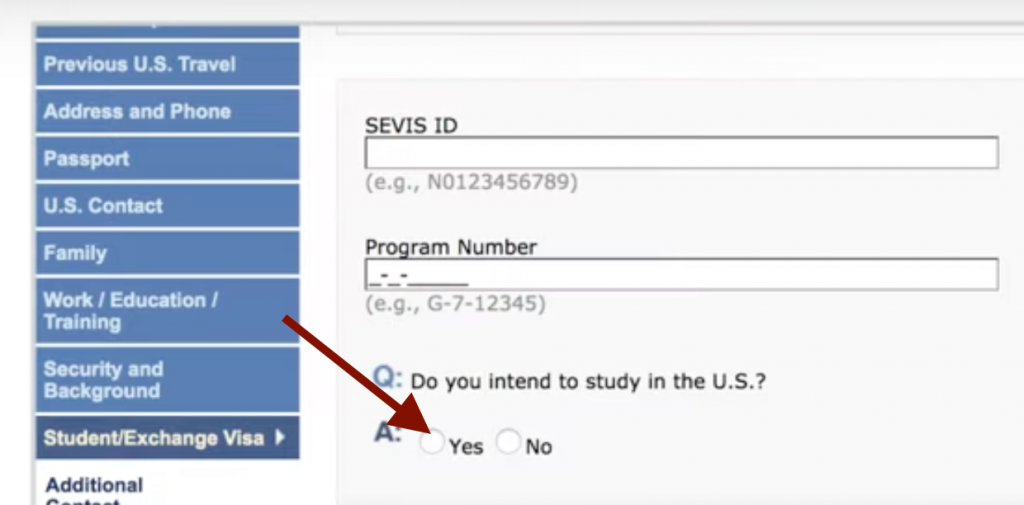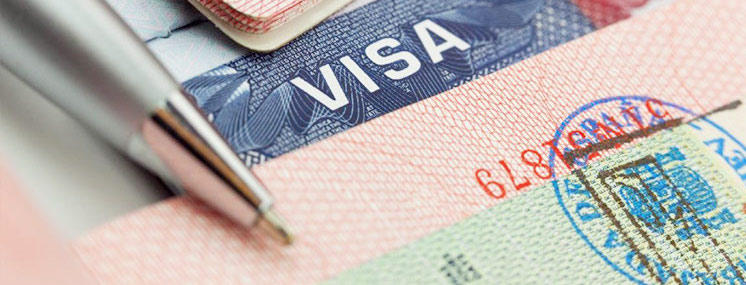J-1 “Exchange Visitor” Visa and Entering the U.S.
This page is for individuals who have received a Certificate of Eligibility for Exchange Visitor (J-1) Status (SEVIS Form DS-2019) for a program of study or teaching at Augsburg University. It describes the process of how to apply for a J-1 visa BEFORE entering the U.S.
Please apply for a J-1 visa (DS-160) well in advance of your planned travel to the U.S. as it can take a few months to obtain a non-immigrant visa at some U.S. Embassies and Consulates (including scheduling/completing your personal appointment/interview). Citizens of all countries (except Canada ) are required to have a J-1 visa to enter the U.S.
Caution: Do not enter on a B-1 or B-2 visitor visa, or in WT or WB status through the “visa waiver” program. It is unlawful for individuals in these classifications to study full time or work in the U.S., and it is difficult and sometimes impossible to change status to J-1 once in the country.
Step 1: Read the Form DS-2019
Please note that your SEVIS Form DS-2019 indicates that we have created a record on your behalf in the Student Exchange Visitor Information System (SEVIS). Please refer to your assigned SEVIS ID number in the upper right hand corner of page 1 of your SEVIS Form DS-2019.
If any information on this form is incorrect, please contact the ISSS office immediately (isss@augsburg.edu). If all of the information on the form is correct, sign your name IN BLUE INK in the appropriate space on the form.
If you have dependents (husband or wife, children under the age of 21) traveling with you, they will receive their own Form(s) DS-2019 to assist with their application(s) for J-2 visa(s). Please contact us if you intend to bring your dependents to the U.S. with you, and you HAVE NOT received separate documentation for your dependent family members.
Note: The spelling of your name and your date of birth must be exactly the same as reflected in your passport. The same is true for dependents. If your name and/or date of birth on SEVIS Form DS-2019 are not exactly the same as the information that appears in your passport, please request that we issue you a corrected SEVIS Form DS-2019.
Step 2: Make Sure Your Passport is Valid
In order to avoid possible problems applying for a visa or entering the U.S., your passport should be valid for at least 6 months beyond the date you plan to stay in the U.S.
Step 3: Apply for a Nonimmigrant Visa (J-1 visa)
The on-line Non-immigrant Visa Application Form DS-160, can be found on the U.S. Embassy website: Apply for a Nonimmigrant Visa.
It may be smart to view this video FIRST as it shows all application steps in detail How to complete a DS-160 and Submit your J-1 Application.
 NOTE: Please remember that under the SEVIS Information section of your visa application, DO SELECT THAT YOU INTEND TO STUDY – so answer YES. The video above suggests saying “NO” (as the video is an example for the InterExchange Program). The process is exactly the same accept for this section. So answer YES here.
NOTE: Please remember that under the SEVIS Information section of your visa application, DO SELECT THAT YOU INTEND TO STUDY – so answer YES. The video above suggests saying “NO” (as the video is an example for the InterExchange Program). The process is exactly the same accept for this section. So answer YES here.
Make sure to “SIGN” and “SUBMIT” your application. Then print out the CONFIRMATION page. You will need this document when showing up for your personal interview.
Step 4: Make an Appointment with the U.S. Embassy or Consulate
Now contact the U.S. Embassy or Consulate in your area to schedule an appointment/personal interview (it is required).
Before your interview, practice answering questions in English about your application, your plans in the U.S., and your plans after you return home. Make sure you tell the truth and be honest. They have all your information and know the answers — they are testing your trustworthiness.
Bring the following documents to this appointment:
- DS-160 Confirmation Page (from your online application)
- SEVIS I-901 Fee Receipt (more information below regarding payment). Pay the SEVIS I-901 fee BEFORE your consular appointment. Make sure to allow sufficient time before your consular visit for your payment to be processed. Call the U.S. Embassy if you have questions. On-line payment with a credit card is recommended
- One photograph which meets all Department of State photo requirements. Verify on-line.
- Valid Passport for at least 6 months into the future beyond your expected stay in the U.S.
- Certificate of Eligibility for Exchange Visitor (J-1) Status (SEVIS Form DS-2019)
- Acceptance letter from Director of International Partners at Augsburg University
- Original documents proving the availability of sufficient funds as stated on your SEVIS Form DS-2019.
- Documents that demonstrate that you intend to return home after the completion of your studies in the U.S.
Paying the SEVIS Fee
The SEVIS I-901 fee is mandated by Congress to support the program office and the automated system that keeps track of students and exchange visitors and ensures that they maintain their status while in the United States. Each student or exchange visitor issued an initial Form I-20 or DS-2019 on after September 1, 2004 is responsible for paying this fee to SEVP. Make sure you print the receipt once you have paid, and place the receipt with your passport for the visit to the U.S. Embassy. Do not lose the receipt, and keep it with your immigration documents.
The Consular Official may decide to run your application through a special “security clearance” before granting the visa. Security clearances may take as long as a few months, so it is very important that you apply for your J-1 visa as early as possible. Most Consular Officials request a security clearance based on the country of national origin of the applicant or on a determined level of sensitivity of your prospective field of study or research. Once the application has been sent for security clearance, the applicant must simply wait until the Consular Post approves the visa
Step 4: Travel to the U.S.
Once you have obtained your J-1 visa, you are ready to travel to the U.S. Immigration regulations allow you to enter the U.S. no earlier than 30 days prior to the start date of your program indicated in Section 3 of your SEVIS Form DS-2019. You must carry with you items 4-8 listed in Step 3 of this handout.
Place these documents in a folder or envelope that you will have with you at all times during your travel. During your trip to, or upon arrival in, the United States, you will be given a form called an Arrival/Departure Record (Form I-94). Using a pen, provide the information requested on this form, making certain to spell your name exactly as it appears in your passport.
Step 5: Apply for “Admission” to the U.S.
When you arrive in the U.S., you will apply for “admission” and an immigration inspector will examine your documents. You will need to present the following documents:
- Form I-94
- Passport with valid J-1 visa
- SEVIS Form DS-2019
You should have the following documents ready to present if the Immigration Inspector asks for them:
- Original financial documents
- Letter of invitation/acceptance from Augsburg University
The Immigration Inspector may ask you one or more questions. If you are asked about your funding, answer the question and offer to show the Inspector your financial documents. If you are asked about your “intentions,” answer the question and offer to show supporting documents. Please be advised that nationals or citizens of certain countries are now subject to a Special Registration when entering the U.S. You may be fingerprinted and photographed at the point of entry. You should calmly provide all information requested by the Immigration Officer.
If you have the required documents and there are no more questions, the Immigration Inspector will “admit” you to the U.S. by processing your passport, your SEVIS Form DS-2019, and your Form I-94.
When you leave the inspection area, make sure you have the following documents in your possession:
- Passport
- Departure Record (part of Form I-94)
- SEVIS FORM DS-2019
- All supporting documents
J-1 Medical Insurance Requirement
As a matter of U.S. law, J-1 students must secure medical insurance as follows for the duration of their J status:
- Medical benefits of at least $100,000 per accident or illness,
- Repatriation of remains in the amount of $25,000,
- Expenses associated with the medical evacuation of the exchange visitor to his or her home country in the amount of $50,000, and
- A deductible not to exceed $500 per accident or illness.
This amount of medical insurance is not optional. It is required by law. Failure to secure this insurance could result in the immediate termination of your J-1 status.
However, this insurance is not required in order to obtain a J-1 visa or to receive J-1 status in the first instance upon admission to the US. It is required in order to keep the J-1 status conferred on you upon entry to this country.
The J-1 status medical insurance requirement includes every J-2 dependent with you in the US: both you and each of your J-2 dependents must be covered by medical insurance as described.
The Two-Year Home Country Physical Presence Requirement
After you finish your J-1 program in the U.S., you may be required to spend two years in your home country, or country of last legal residence, before you will be allowed to return to the U.S. in certain types of immigration classifications. You may be subject to this requirement if:
- Either the U.S. government or your home government directly funds your activities in the U.S.
- Your prospective field of study or expertise appears on a document called the “Skills List”, or
- You will receive graduate medical education or training.
If you have any questions about the two-year home country physical presence requirement, please contact me for more information.
Additional Information
We would be pleased to provide you with further information, advice, and assistance on any visa or immigration matter that relates to your activities at Augsburg University. For more information on U.S. Embassies and Consulates, on the visa application process, and on the “J Exchange Visitor” program, you may visit the U.S. Department of State website at http://travel.state.gov/.

